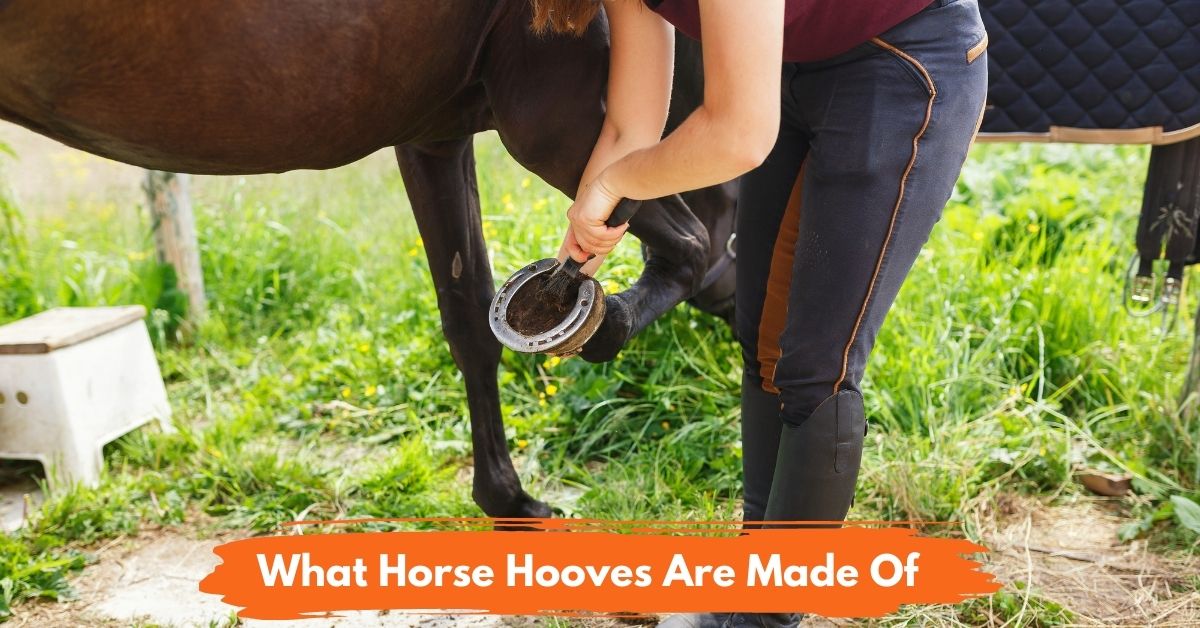
What are horse hooves made of? Horse hooves are generally made of keratin. Keratin is a protein that’s also found in human hair and nails. It’s the compound responsible for giving these structures their strength.
A horse’s hooves are the equivalent of our fingernails. They grow continuously and need regular trimming. To know how to maintain your horse’s hooves, it’s important to know everything about them.
This article will show you just that! Discover what horse hooves are made of, how they grow, and the best ways to take care of them. Horse hooves have three main parts: the outer structure, the inner framework, and the sole.
Outer Structures of Horse Hoof
The horse hoof’s outer structures are the hoof wall, laminar layer, periople, and coronary band.
Hoof Wall
The hoof wall is the tough layer in the outer part of the horse hoof. It’s made up of dead cells that contain lots of keratin. It protects the hoof’s inner components. It also provides insulation for the sensitive tissues inside the hoof.
For the hoof wall to stay strong, it needs to be tough and elastic. This way, it can absorb the impact shock when the horse’s hooves hit the ground. To achieve this, the hoof wall has a tough outer layer and a spongy inner layer.
The tough outer layer is made up of densely packed keratin-rich cells. This layer is what you see when you look at the hoof. It’s hard and keratin-rich, which makes it strong and durable.
On the other hand, the spongy inner layer helps the hoof wall absorb shock. It’s also where new cells grow to replace old ones.
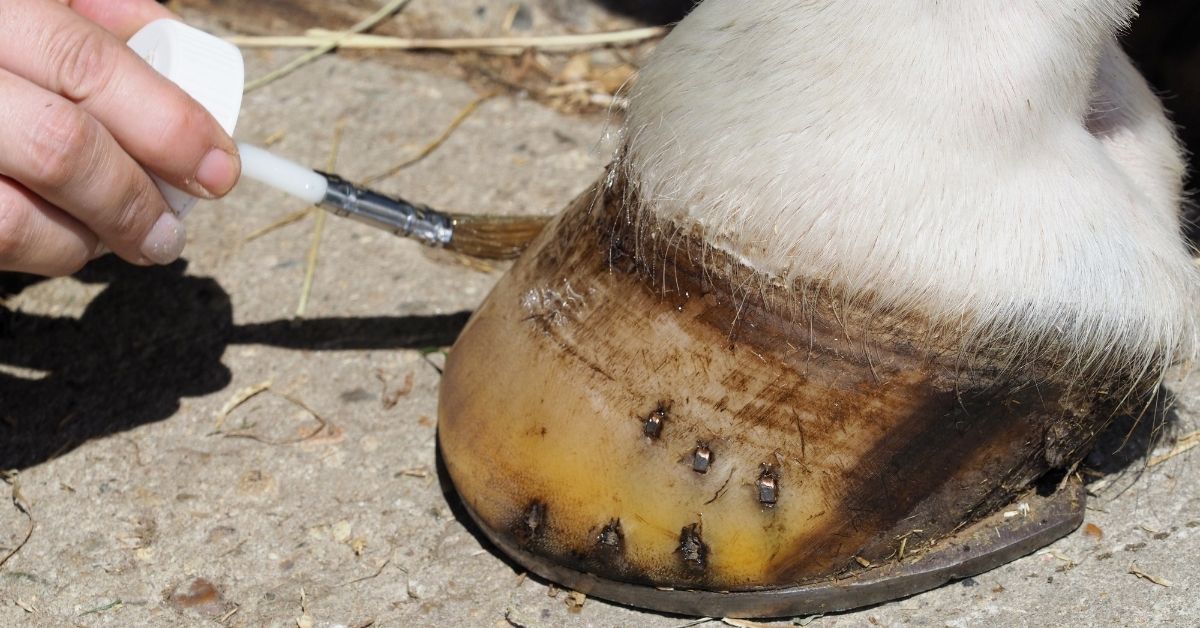
Coronary Band
The coronary band is the soft, fleshy tissue at the topmost portion of the horse hoof. It’s also called the hairline because it’s where the boundary between horse’s coat and the hoof. This part of the horse hoof is alive and contains cells that produce the hoof wall.
This area in the horse hoof is very important because it’s responsible for horse hoof growth. The cells divide and grow to form new hoof wall cells. In turn, these new cells push the old ones down the hoof. This is how the hoof wall grows.
Periople
The periople is a waxy substance that covers the hoof wall. The substance inside the horse hoof’s coronary band secretes this substance, which then protects the hoof from the outdoor elements, infection, and debris. When it comes to horse hooves, the people serve an important purpose. It helps protect the hoof wall from damage and keeps it strong and healthy.
Without the periople, the hoof wall would be susceptible to infection. It wouldn’t be able to grow properly. The harsh environmental conditions can damage the periole easily. That’s why it’s important to reinforce the periople with regular hoof care.
By caring for your horse’s hooves and keeping them clean and free from debris, you can help the periople do its job.
Laminar Layer
The laminar layer is a tough, fibrous tissue that attaches the hoof wall to the inner structures of the hoof. It’s made up of collagen and other proteins that give it strength and flexibility. The laminar layer provides ample shock absorption. This feature prevents the hoof from cracking.
Horse hooves are constantly expanding and contracting as the horse walks or runs. This causes a lot of stress on the hoof, leading to cracking. The laminar layer helps prevent this by absorbing shock and providing flexibility.
Inner Framework
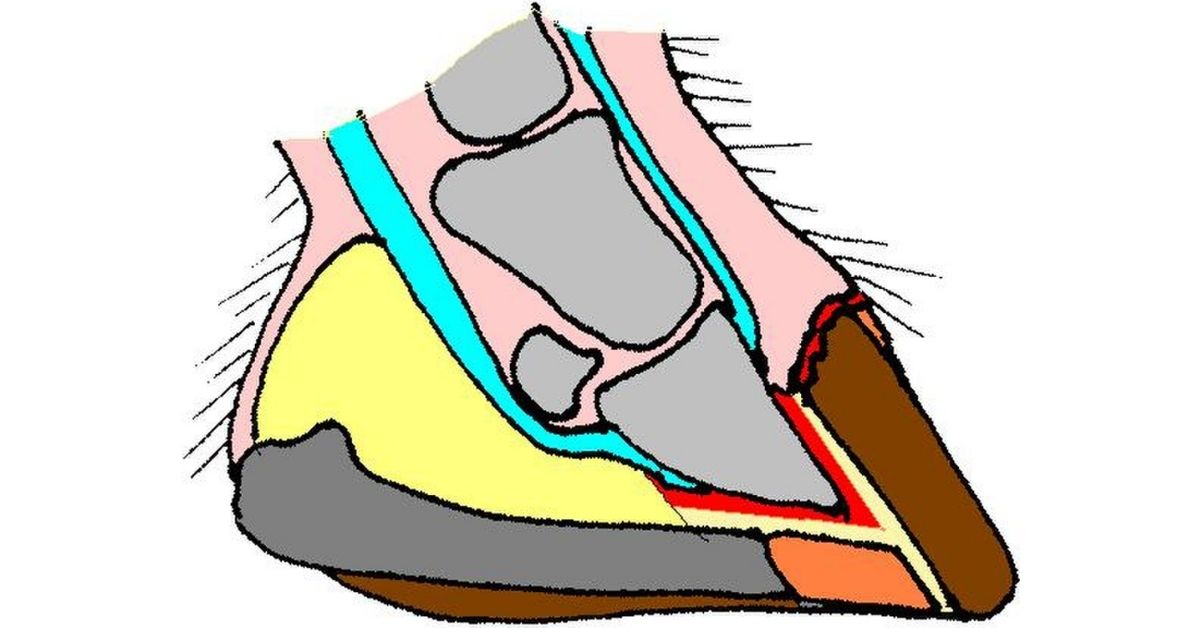
The inner framework is the structure that supports the hoof and gives it its shape. It’s made up of the digital cushion, coffin bone, and navicular bone.
Digital Cushion
The digital cushion is a pad of fatty tissue located at the hoof’s bottom. It also helps absorb shock and provides cushioning for the horse’s foot. At the same time, the digital cushion also helps pump blood back up the leg.
The digital cushion is situated close to the frog and plays a vital role in a horse’s ability to withstand heavy blows on the foot. With its elastic and collagenous fiber, it helps to reduce the impact of each step. Horses will need the shock absorption properties of the digital cushion to protect their legs from injury.
Coffin Bone
The coffin bone is a flat, triangular bone located in the center of the hoof. It’s attached to the laminar layer and supports the hoof wall. This bone also helps the horse balance when walking or running.
This bone in the horse hoof got its name because it’s encased inside the hoof—similar to a corpse in a casket. It’s the largest bone in the horse’s foot and makes up a big part of the hoof’s inner framework.
The navicular bone is a small, boat-shaped bone. It’s also attached to the laminar layer and helps support the hoof wall. In addition, the navicular bone helps the horse move its foot when walking or running.
The purpose of the navicular bone is to act as a shock absorber. It’s located in an area of the hoof that experiences a lot of stress and impact. By absorbing this shock, the navicular bone protects the horse’s leg from injury.
Underneath the Horse Hoof
The bottom of the hoof is made up of tough, fibrous tissue that helps protect the horse’s foot from injuries. It also provides traction and helps the horse balance when walking or running. Underneath the horse hoof is composed of the sole, frog, central sulcus, and bars.
Sole
The sole is the hard, flat surface on the bottom of the hoof. It’s made up of dead cells that contain lots of keratin. The sole protects the sensitive inner tissues and helps the horse maintain proper balance.
The horseshoe is attached to the palmar part of the sole and helps protect it from wear and tear. In addition, the sole provides traction and helps the horse grip the ground when walking. A horseshoe also increases traction, which helps the horse prevent slips and falls.
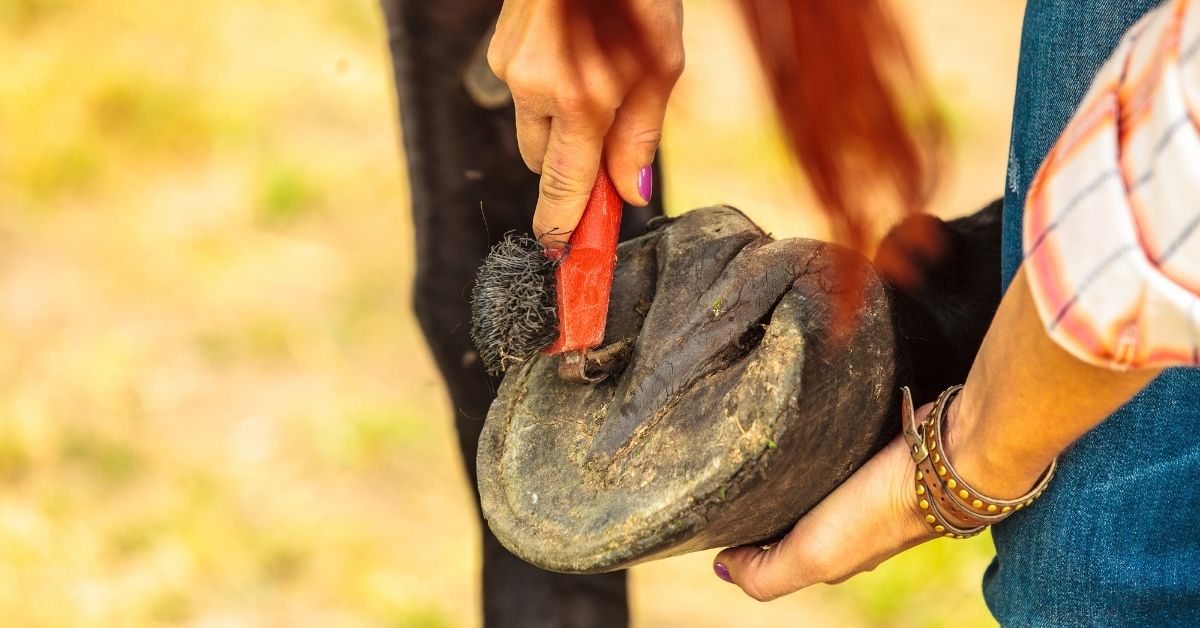
Frog
The frog is a V-shaped mass of tough, fibrous tissue located in the center of the hoof. It also absorbs shoes and serves as cushioning for the horse’s foot. In addition, the frog also helps pump blood back up the leg.
The frog is similar to the human heel pad and is an important part of the horse’s shock-absorbing system. With its spongy texture, it helps to reduce the impact of each step.
Central Sulcus
The central sulcus is a groove that runs along the center of the frog. This groove helps to channel blood and lymph fluid from the horse’s foot. It also helps to protect the series of tissues found inside the hoof.
It’s easy to spot the central sulcus on a horse’s hoof—the area at the frog’s rear is located right in the middle. It looks like a small indent that thrushes love to reside in. Because of this, the central sulcus is also known as the “thrush groove.”
Bars
The bars are two thin, flat pieces of tough, fibrous tissue on either side of the frog. They’re attached to the hoof wall and help support the horse’s weight. In addition, the bars also help the horse move its foot when walking or running.
The bars strengthen the heel area and control the heel’s overexpansion. This area also builds the sole of the hoof and supports the horse’s weight. Therefore, the bars need to stay healthy and free from any infections.
Any infection in this area can cause the horse much pain and make walking difficult. To prevent this, the bars need to be trimmed regularly.
When trimming the bars, ensure the white lines are still visible. These lines indicate where the bar meets the hoof wall. If these lines are not visible, it means that the bars have been trimmed too short.
Conclusion
The horse’s hoof isn’t the most complex structure in the animal kingdom, but it’s still an impressive feat of nature. They’re tough, durable parts of a horse well-suited for life on the open plains.
If you have a horse, it’s important to learn how to care for its hooves. This includes knowing when and how to trim them. Doing so can help keep your horse comfortable and prevent hoof-related problems from developing.
FAQs
Why Do Horses Have Hooves?
Horses have hooves because they’re descendants of a prehistoric mammal, the mesohippus. This mammal had four legs and hooves instead of nails on its feet. Over time, the mesohippus evolved into the modern horse.
Today, horses still have hooves because they’re well-suited for life on the open plains. Hooves are tough, durable, and help horses travel long distances without wearing down.
The hooves play a vital role in helping horses run faster and farther and jump higher. They also help maintain a horse’s balance to the ground. This is especially helpful when moving at high speeds.
Hooves also help protect the horse’s feet from injuries. At the same time, it provides ample traction when walking or running. With their tough, keratin-rich exterior, hooves can withstand a lot of wear and tear.
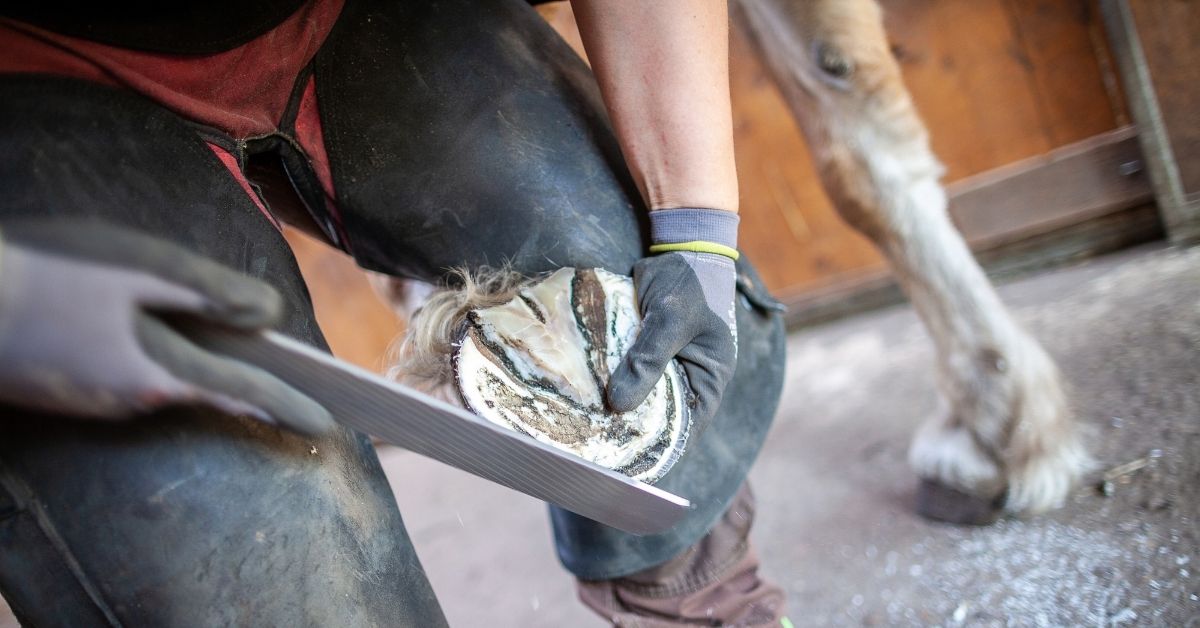
Why Do Horse Hooves Need To Be Trimmed?
Hooves need to be trimmed for two main reasons:
- To keep them at a manageable size
- To prevent them from overgrowing
If hooves are allowed to overgrow, they can crack and break. In addition, overgrown hooves are more likely to collect dirt, stones, and other debris. This can lead to serious infection and other health issues.
From a horse’s perspective, overgrown hooves are uncomfortable and make movements difficult. Trimming the hooves helps keep them at a comfortable level for the horse.
Wild horses don’t need to trim their hooves because they live on open plains where they can roam freely. Their hooves have also adapted to the terrain, which helps prevent them from overgrowing.
On the other hand, domestic horses need to have their hooves trimmed on a regular basis. These variants of horses are usually confined to stables or paddocks. They’re more likely to have overgrown hooves because they don’t have as much opportunity to wear them down.
How Often To Trim Horse Hooves?
How often a horse’s hooves need to be trimmed depends on several factors, including the horse’s age, activity level, diet, and environment.
Generally speaking, most horses need to have their hooves trimmed every four to six weeks. However, some horses may need to be trimmed more often, while others may only need to be trimmed once every two months.
If you’re unsure how often to trim your horse’s hooves, talk to a veterinarian or a professional hoof care provider. They’ll be able to give you specific advice based on your horse’s individual needs.
